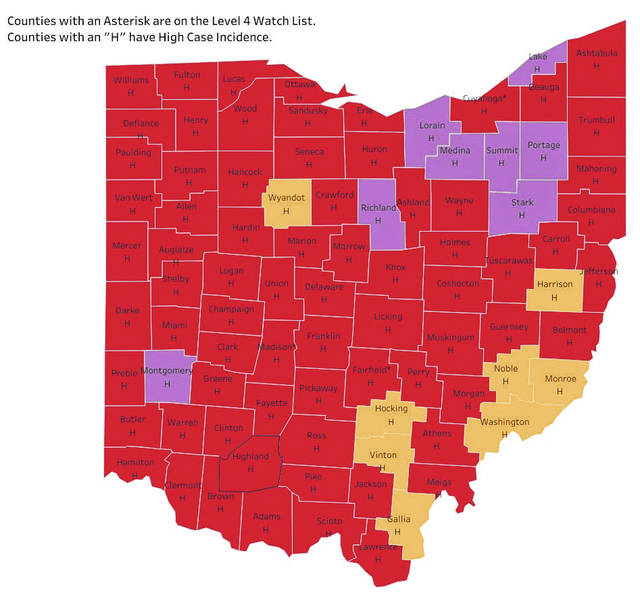
Fairfield Local Superintendent Tim Dettwiller announced Friday that the district will return to traditional, in-person learning on Monday, Dec. 7.
The district transitioned to its blended learning plan on Nov. 19 after an increase in quarantines involving students and staff members.
During the district’s Nov. 23 school board meeting, Dettwiller reported that the blended learning schedule had drastically reduced the number of students quarantined due to close contact with confirmed COVID-19 cases.
In a Friday statement on the district’s website, fairfieldlocal.org, Dettwiller requested that Fairfield students, staff and parents be prepared to return to the blended learning plan in the event of a future spike in positive cases or quarantines.
“I want to thank all of you for adjusting your work and home schedules to flex with our transitions between learning plans,” Dettwiller wrote. “As I have indicated in the past, our number one priority is the safety of our students and staff. We will continue to monitor daily our positive cases and quarantines and will also continue to share that data with you through our COVID tracker on the front page of our website.”
Also on Friday, Ohio Gov. Mike DeWine announced that COVID-19 vaccine distribution will begin in Ohio on or around Dec. 15. As vaccine supply will be limited initially, only individuals included in the state’s Phase 1A plan will have the option to get vaccinated at that time. Phase 1A focuses primarily on high-risk health care workers and first responders as well as assisted living residents and staff and those with intellectual disabilities and mental illness who live in group homes.
In local Covid-related news, the Highland County Health Department reported that it would be closed to the public beginning Thursday, Dec. 3 due to its “first brush with COVID-19” within the health department.
As of Thursday, the health department will reopen to the public on Monday.
No updates regarding Highland County’s Covid statistics were available from the health department as of press time.
As of Thursday, Highland County remained a “red” county with high case incidence, according to the Ohio Public Health Advisory System (OPHAS).
“Red” counties, which OPHAS also classifies as level 3 public health emergencies, have “very high” COVID-19 exposure and spread.
In the past two weeks, Highland County has had 262 new cases, or 607.03 new cases per 100,000 residents, according to OPHAS.
Warner previously stated that the county must have under 100 new cases per 100,000 residents to decrease from a “red” rating.
Out of Ohio’s 88 counties, 72 counties were rated as “red” counties; eight counties were rated as level 2 “orange” counties.
As of Thursday, eight counties were rated “purple” level 4 public health emergencies, which designate severe exposure and spread.
Residents in “purple” counties should only leave home for essential supplies and services, according to OPHAS.
No counties were rated as level 1 “yellow” counties, the lowest rate of exposure and spread.
According to the ODH, which reported 1,267 cumulative cases in the county as of Friday, of the cases in Highland County:
* 205 cases involved 50- to 59-year-olds. Of these cases, 11 resulted in hospitalization.
* 189 cases involved 60- to 69-year-olds. Of these cases, 13 resulted in hospitalization, and two resulted in death.
* 181 cases involved 40- to 49-year-olds. Of these cases, six resulted in hospitalization.
* 159 cases involved 20- to 29-year-olds. Of these cases, one resulted in hospitalization.
* 155 cases involved 70- to 79-year-olds. Of these cases, 24 resulted in hospitalization, and six resulted in death.
* 154 cases involved 30- to 39-year-olds. Of these cases, one resulted in hospitalization.
* 130 cases involved 0- to 19-year-olds. Of these cases, one resulted in hospitalization.
* 85 cases involved someone 80 years old or older. Of these cases, 14 resulted in hospitalization, and 10 resulted in death.
* Nine cases involved patients of unknown ages.
Warner previously stated that there is a delay in the reporting process between individual counties and the ODH.
As of Friday, a note on the ODH’s website read, “Today’s data is incomplete. Because of unprecedented volume, thousands of reports are pending review. Please bear with us as we work through this surge in testing.”
For more information on COVID-19 in Ohio, visit coronavirus.ohio.gov.
Reach McKenzie Caldwell at 937-402-2570.


